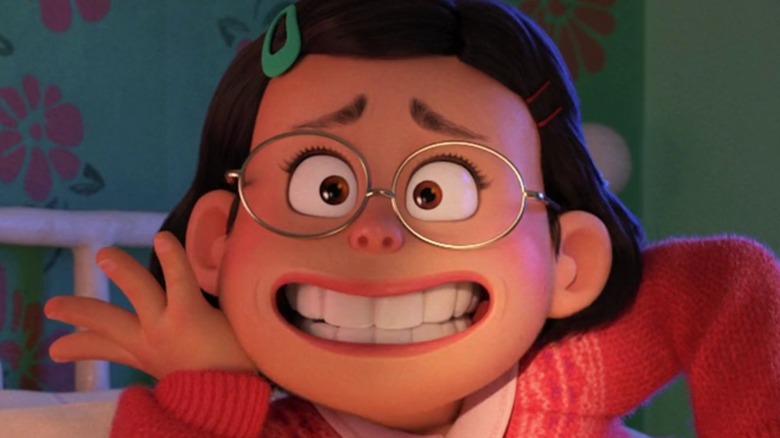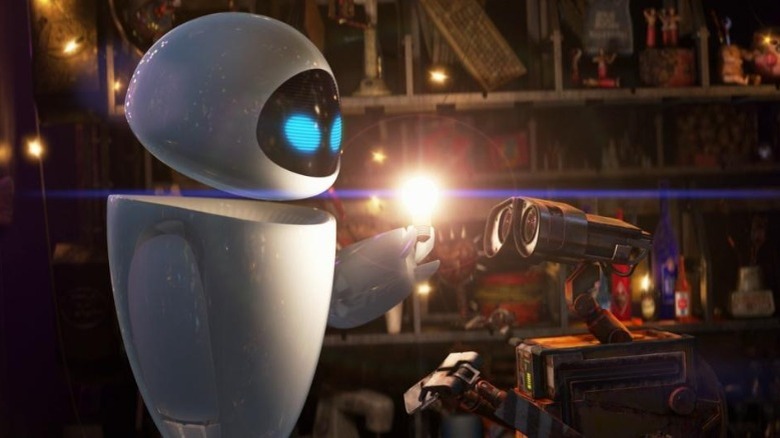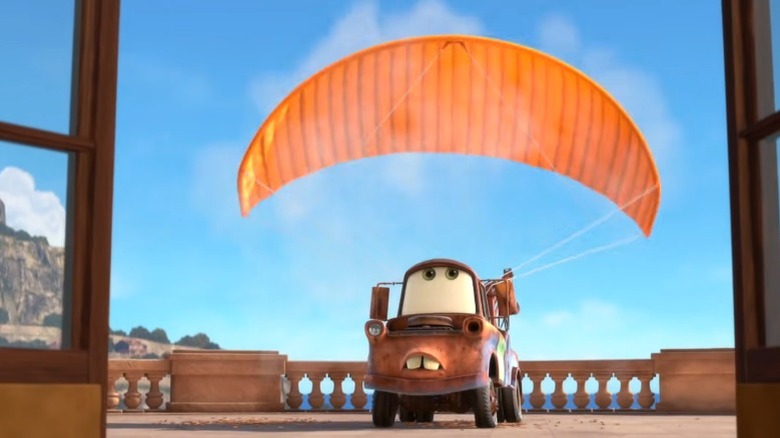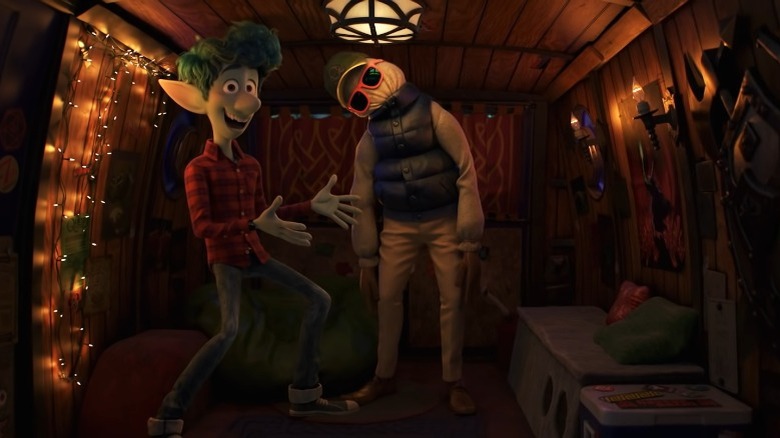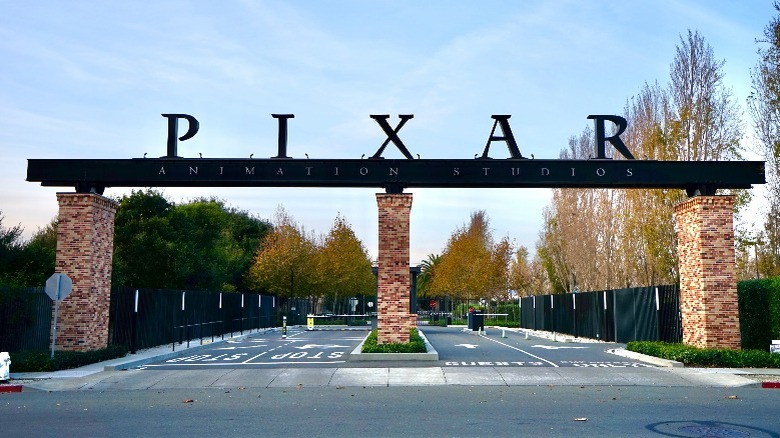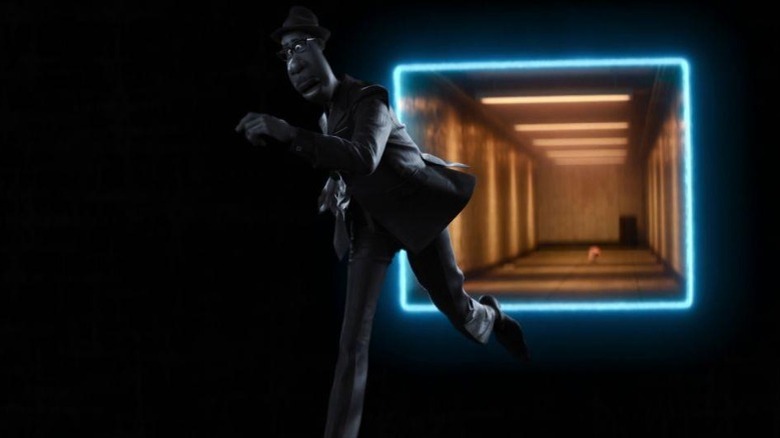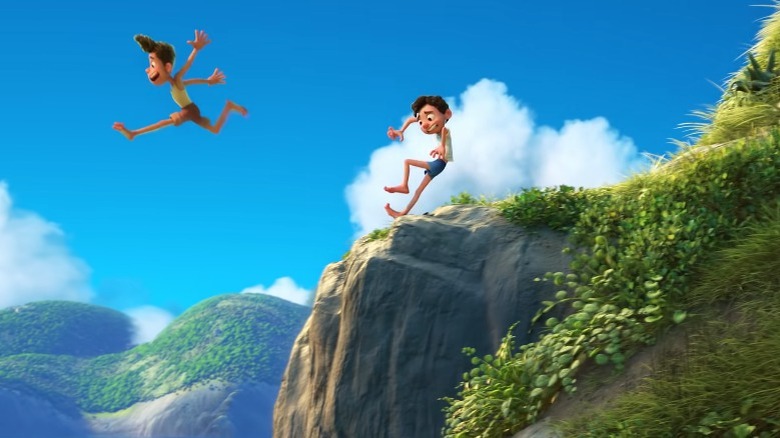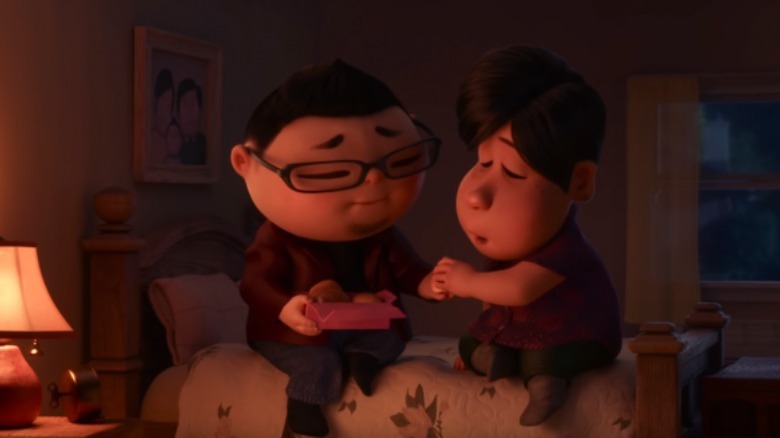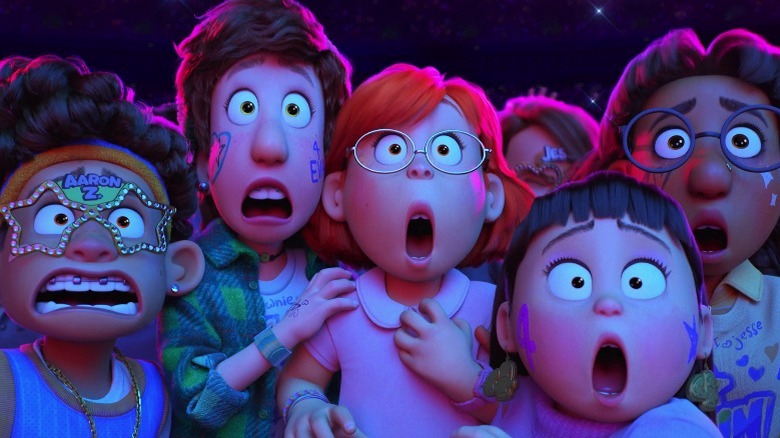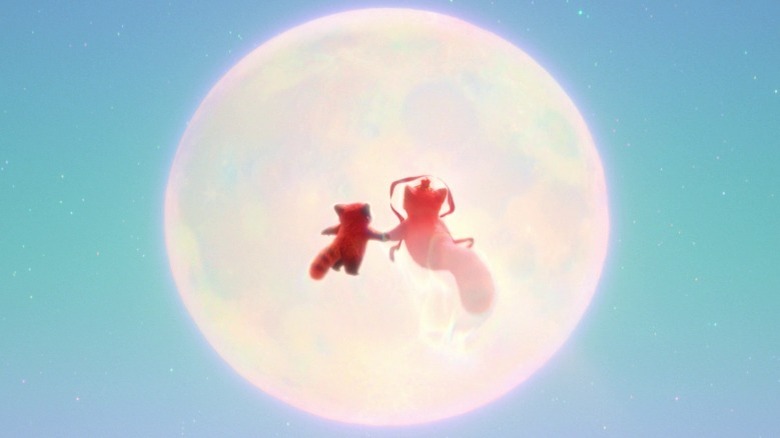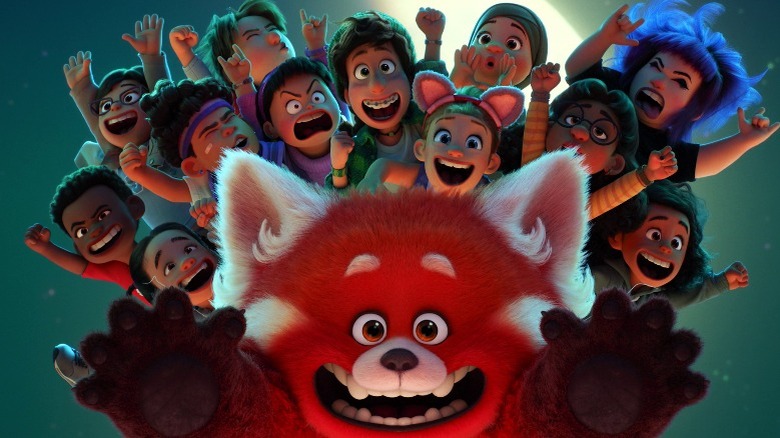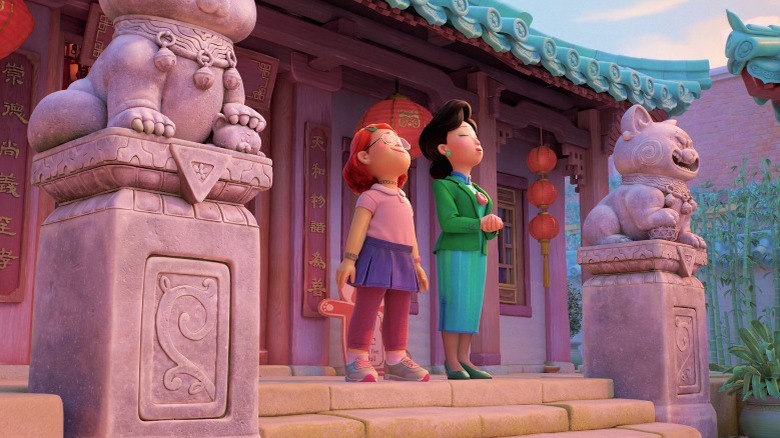Turning Red Controversy Is Exactly What Pixar Needed
The latest film from Pixar Animation Studios, Domee Shi's "Turning Red," has been met with an inordinate amount of controversy. From one critic deeming it too culturally specific and personal to be relatable to a wide audience (as reported by NBC News), to online reviewers taking issue with its hyper-stylized, anime-inspired animation style, to numerous angry parents — as well as several conservative media outlets — lambasting it for its honest depiction of female puberty, periods, and teen rebellion, it's truly impressive how many feathers have been ruffled by a fun kids' comedy about a cute red panda. Things got to the point where outlets like Vox and The Daily Beast even felt the need to pen responses to the "Turning Red" ruckus, coming out in its defense as a harmless little movie that got senselessly dragged through the mud.
But here's the thing everybody seems to be missing: What if the controversy was not, in fact, senseless? In fact, what if it was not even a bad thing at all? Sure, it's understandable that fans of "Turning Red" — a brilliant, endearing movie by any measure — should want to shield it from the angry hordes and encourage as many families as possible to see it with an open mind. However, the very thing that makes "Turning Red" so brilliant and moving is its defiant, rule-breaking spirit. It's a movie that willfully invites controversy, in more ways than one. And, in fact, that's exactly what makes it a crucial turning point for Pixar at this juncture in its history.
Pixar used to be at the vanguard of Hollywood
What feelings do the words "Pixar movie" bring to your mind?
The common answer now may be a lot different from the one that was ordinarily given some years ago. For the past two and a half decades, Pixar has been a major cultural institution. First, courtesy of "Toy Story," it was the purveyor of tech newness that brought animated cinema into a brave new era by showing it was possible to tell moving, visually daffy stories with nothing but CGI. Then, from "Toy Story 2" and "Monsters, Inc." onward, it embarked on one of the most sterling runs from a film studio in recent memory, putting out hit after hit with an almost supernatural command of original, four-quadrant storytelling both kids and grown-ups could enjoy. Then, it parlayed all that goodwill into a period of radical experimentation within the medium it had inaugurated, exploring bold, untapped cinematic avenues that pushed the boundaries of what Hollywood considered "family entertainment." And then, inevitably, it was bought by Disney in 2006.
The last Pixar movies to begin production before the $7.4 billion House of Mouse buyout (via CNN) were "Ratatouille," "WALL-E," and "Up" — three innovative, artistically outreaching masterpieces that exemplified what the Pixar team was capable of when working at the height of their powers with creative abandon. Following those three movies' development, Pixar began to function as a de-facto subsidiary of Disney. And it was then that something decisively shifted.
Disney put Pixar on a conformist path
By the late 2000s, Pixar's "headstart" in CGI animation had been exhausted. Competition from studios like DreamWorks and even Disney itself was becoming stiffer and stiffer, with CGI animation by then a tamed beast, and the "Pixar model" of smart, tear-jerking, adult-friendly kids' cinema now fully industrialized and imitable. Pixar could, of course, have continued to stand out from the pack by sticking to the ambitious avant-garde path it had begun to chart during the "Ratatouille"-"Up" run. But the Mouse doesn't do avant-garde: It pigeonholes, and optimizes commercially.
In an ominous sign of things to come, Pixar's immediate first mission after the buyout was to salvage the "Toy Story" threequel Disney had been trying to strong-arm into production without them. Sure, they succeeded with flying colors. "Toy Story 3" is still one of the greatest sequels of all time. But, for a studio that had done only one sequel — "Toy Story 2" — thus far, the production pipeline suddenly began to look very different.
Between sequels, prequels, and unexpected four-quels, Pixar produced a total of seven franchise extensions in the subsequent years. In the same period, their original production was marred by major development woes: "Brave," "The Good Dinosaur," and the ultimately scrapped "Newt" all suffered from backstage tugs-of-war over what kinds of movies they should be. The studio had never made so much money — "Finding Dory," "Incredibles 2," and the "Toy Story" sequels were all massive billion-dollar hits. But something was lost in the shuffle.
Even Pixar's original films began to feel boxed in
The most telling indictment of Pixar's cultural twilight in the 2010s was that even its original films began to feel different. In addition to the aforementioned "Brave" and "Good Dinosaur," which visibly came out the gate as messy, workshopped-to-a-fault concoctions, films like "Coco" and "Onward" demonstrated that the tried-and-true Pixar formula was beginning to yield diminishing returns. "Coco" was a sweet, moving film, but it was so concerned with being agreeable and kid-friendly that it shortchanged its own narrative potential, opting for a simplistic resolution and a cartoony villain instead of the complex familial reckoning it feinted at exploring. "Onward," meanwhile, was a solid, well-made, satisfying helping of Classic Pixar — and it was so painfully generic it barely made a cultural blip.
Popular as they were among families, these were not films that really pushed the medium forward and galvanized culture the way "The Incredibles" or "WALL-E" or "Ratatouille" did, and that was by design. Under Disney, Pixar's express entrepreneurial purpose was to fulfill the role of "universally beloved family animation studio" by continually aiming to please everybody and their mother, be it via sequels or safe rehashes of their past hits' emotional beats. Tellingly, where they used to pride themselves on putting out classic after classic, the Emeryville studio only produced one stone-cold classic in a near-decade: 2015's "Inside Out," a film hailed precisely for its creative boldness and willingness to go to dark, thorny, challenging emotional places.
It turned out that trouble was coming from inside the house
In late 2017, a while after "Onward" had begun development, the tide began to turn for Pixar. First, John Lasseter, once the beloved Hollywood maverick who'd put the studio on the map, was ousted from his CCO position at both Pixar and Disney following a wave of sexual misconduct allegations (via The Hollywood Reporter). Then, not long after, it came out that Lasseter's alleged behavior might have been part of a larger, corrosive culture of misogyny and boys-club thinking that had been allegedly plaguing Pixar for years (via Variety).
These developments threw into sharp relief previous events such as the firing of the great Brenda Chapman from her own brainchild "Brave," and Rashida Jones' exit from the writers' room of "Toy Story 4." It became obvious that, more than settling into artistic stagnation, Pixar had become mired in corporatist conformity, with bigwigs protecting themselves and each other at the expense of a healthy and open creative environment, and chasing away any number of fresh new voices in the process.
The ousting of Lasseter and major staff overhaul, with "Up" and "Inside Out" mastermind Pete Docter now at the helm (via Variety), prompted a long-overdue reckoning with Pixar's standing in the movie industry. Where should Pixar go next? What should a Pixar movie be? The answers provided by subsequent movies said a lot, both about Pixar itself and about the cultural perception of their work.
Turning Red arrives amid a climate of tentative renovation
When Pete Docter was announced as the new head of Pixar in 2018, he was working on what would become 2020's "Soul." As a movie, "Soul" was, in many ways, quite illustrative of the stalemate in which Pixar now found itself. There was a conspicuous tension in it between its auteur's wilder, more outré instincts and the commercial need to fall in with the perfectionist pop-drama recipe Docter himself helped develop. It felt like a movie that wanted to go all the way off the existential deep end, to go further than any Pixar movie had ever gone, but had to keep returning to a safe, easily digestible realm.
Ultimately, what felt truly new and memorable about "Soul" was not so much its philosophical outreach, but the very thing that would be provided in spades by the following year's "Luca" — personal, small-scale specificity. Thanks to the input of co-director Kemp Powers, moments like the barbershop scene felt like they were coming from an authentic, deeply-felt place, industrial expectations and mandates be damned. "Luca" would later turn out to also be like that, but full-time: Rather than yet another crowd-pleasing white elephant, it was a simple, affectionate exploration of director Enrico Casarosa's own childhood memories of the Italian seaside. As heralds of the post-Lasseter era, both films signaled a momentous shift towards a kind of filmmaker-first philosophy Pixar had never tried on before. And the consequences were immediate — for good and for ill.
Pixar was backed into a corner, and responded in the best way possible
When Casarosa and company had the gall to fashion "Luca" as a different, more personal, less plot-minded version of a Pixar movie, two things happened. First: Even as fellow mid-2021 Disney films like "Cruella," "Black Widow," and "Jungle Cruise" were being given a chance to play in theaters, "Luca" was banished to Disney+, never to see the light of a projector. Second: The critical mainstream, once Pixar's biggest brand-building ally, reacted to the film with apathy bordering on indignation, deeming "Luca" insufficiently ambitious, insufficiently life-changing, too wistfully low-stakes to hold a candle to past hits — in short, the critical mainstream asked for another "Up." What this demonstrated was that the studio's artistic impasse wasn't just a result of corporate conformity — it was also the product of the audience expectations Pixar had backed itself into.
"Luca" garnered a small following of incredibly passionate fans who connected deeply with its characters, but the Disney+ distribution showed that the Mouse never trusted its commercial potential. Now, with every new Pixar movie fated to be seen as either "too much like old Pixar" or "not enough like old Pixar," the studio was faced with a choice: Commit to the renovation and alienate some nostalgic viewers, thereby losing its standing as de-rigueur Hollywood unanimity, or go back to the routine of sequels and rehashes, thereby risking impending cultural irrelevance.
And this is where the weird, cringey, gyrating antics of "Turning Red" come in.
The only way forward for Pixar is to take real risks again
When Chinese-Canadian animator Domee Shi was poached to make a new feature film for Pixar, all the studio had to go on as evidence of her filmmaking sensibility was "Bao" — a shocking, abrasive, unabashedly personal short film that baffled and confused many with its tale of an overly-attached immigrant mother. The fact that Pixar would choose to bet its chips on Shi, even after the polarized audience reception to "Bao," demonstrates why "Turning Red" is such an important moment in the studio's trajectory: because it's a real risk.
We don't talk often enough about the fact that Pixar's titanic reputation build-up in the 2000s was largely defined by risk-taking — genre subversion, out-there story ideas, comedic and dramatic tones usually reserved for grown-up movies. This is a studio that centered its first film around an unlikable, entitled antihero, hired Albert Brooks to be the lead of its big financial bet while rivals were modeling fish after Will Smith and Angelina Jolie, and spent blockbuster money on a screwball comedy about rats in the kitchen — not to mention, opened a movie with 40 minutes of no dialogue. If the absorption of the Pixar model by the animation industry at large has stripped that model of its danger, then the only way for Pixar to be Pixar again is to up its adventurous ante. And that's precisely what "Turning Red" does, in both form and content.
Turning Red is the Pixar movie we've all been waiting for
For those of us who have long been invested in the evolution of Pixar as a studio and itching to see it live up to the potential it once demonstrated, "Turning Red" is the movie we've been waiting for.
Much like "Luca" and the New York City sections of "Soul," it continues Pixar's tentative modus operandi of embracing singular, lived-in personal visions over broad-appeal architecture, and goes even further than those films by digging into the uncomfortable, unspoken crannies of the personal experience in question. If Brenda Chapman was previously denied the opportunity to finish her own Pixar film the way she wanted to, "Turning Red" finds Domee Shi in total command of her vision, realizing it fully and without compromise. And, if films like "Coco" and "Soul" established an odd pattern of white filmmakers helming stories about marginalized cultures, which were then inhabited and honored largely via dutiful, well-behaved research, "Turning Red" evidences the magic that can happen when a filmmaker of color dives into a complex, no-holds-barred, emotionally involved exploration of her own cultural identity, with all the cunning in-jokes and sharp observations that could never have been written by committee — a testament to Shi as well as her co-screenwriter, acclaimed Korean-American playwright Julia Cho.
In short, it is a bold, impassioned film. And the amazing results of that boldness go to showing why it's vital that Pixar keep taking big swings.
By embracing risk, the movie accesses new echelons of comedy and catharsis
At its heart, "Turning Red" is a movie about a particular human experience. Even with supernatural elements galore, everything in the film goes back to Mei (Rosalie Chiang) — her thoughts, her fears, her self-perception, her new, confusing feelings. The movie doesn't angle for shock for its own sake, but it does give Mei's inner life room to unveil itself in dashing colors, unapologetically, without suppression or embellishment.
On a basic storytelling level, this allows "Turning Red" to be one of the most rewarding and profound coming-of-age films in years, one that faces its protagonist's growing pains head-on and enables her to search deep for the answers she needs. But, considering the specific person Mei is, "Turning Red" also becomes much more than just one girl's story. Unencumbered by efforts to make her vision "palatable" to a mass audience, Domee Shi repeats the magic trick of "Bao" and imbues her film with jolts of piercing truth. From the "cringe" depictions of hormonal crushing and boy-band cult-dom to the girly friendship codes to the loving yet complicated mother-daughter relationship, the understanding Shi shares of what it felt like to be a tween girl, and specifically an Asian-Canadian tween girl in early-2000s Toronto, makes for an experience as painfully, uniquely hilarious as it is disarmingly cathartic. It is a weird, often shocking movie, yes — as weird and shocking as a movie about being 13 and experiencing cultural whiplash should, but so rarely would, be.
The controversy confirms it as a step in the right direction
The critics and commentators who came out in vaguely condescending defense of "Turning Red" have got one thing right: It really is a movie that shouldn't be controversial. In a healthy social environment with a productive relationship to pop culture, movies that grapple honestly with teen experience should be a dime a dozen, animated or otherwise. In a world that didn't stigmatize open dialogue about the realities of puberty as being synonymous with — rather than the most efficient and crucial deterrent to — trauma and exploitation, the mention of periods in a Disney film shouldn't be cause for indignation. Even the claims that the film is "too specific" and "lacks mass appeal" are symptomatic of a deeply closed-minded culture — after all, what makes the Asian-inspired aesthetic sensibility of "Turning Red" any less acceptable than the European-inspired animation and designs of traditional Disney films?
But here's the kicker: Domee Shi knew all that when she set out to make "Turning Red." The movie doesn't just naively ignore all those arbitrary taboos, it actively interrogates them. "Turning Red" is also a film about a social milieu that doesn't do right by girls, by vexed teenagers, by immigrants and their children. It asks why that world should be the way it is, and imagines a better, happier one, for Mei and her mother Ming (Sandra Oh) alike. It's no wonder it made people angry. That just confirms it did its job right.
Pixar seems to have learned the right lessons from it
There's no way to know how much of a box office hit "Turning Red" would have been if it had made it to theaters. All we know is that Disney, once again, mistrusted it enough to confine it to Disney+. Pixar could have responded to this, and to the surrounding media circus, by backtracking on the auteur-driven innovation. But, as suggested by their recent promotion of Domee Shi to a leadership position among the mighty "Pixar Braintrust" (via Variety), conformity no longer seems to be in the cards.
Shi's promotion offers exciting confirmation of a tendency that seemed to be in full swing back in January 2021, when The Hollywood Reporter ran an extensive profile of Pete Docter's work as CCO. Unsurprisingly for the guy who originally encouraged Shi's kooky filmmaking aspirations when she was still a story artist, Docter was revealed to be shepherding Pixar in precisely the direction it should go — resolutely, intrepidly, towards the future. With newly-placed initiatives towards gender parity and racial diversity, the likes of Aphton Corbin getting the chance to develop feature projects, and a renewed philosophical focus on original films and stories, the studio seems all set to embrace the proud newness and uniqueness of "Turning Red" as a shining model of what it can be. And, if future films keep favoring new ideas, marginalized directorial perspectives, and thorny subjects, Pixar might just go back to being the indispensable cinematic atelier it once was.
